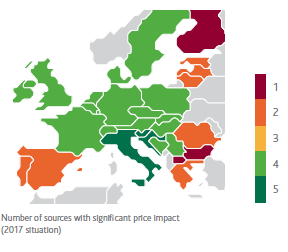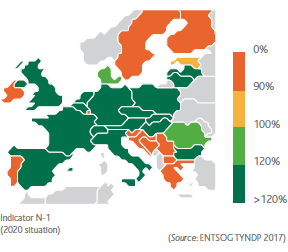Snam’s strategy
Snam’s business strategy is instrumental to making available the energy that the market requires, safely and at a fair cost, and enhancing and reinforcing the centrality of the gas system on the European and Italian energy scene.
To achieve these objectives Snam, a leader in the management of gas infrastructure, shall invest approximately €5.0 billion over the next five years of which 4.7 to expand the national network and integrate it with continental markets, for the maintenance of infrastructure, as well as for new integrated services for system operators, sold on the basis of market regulations.
In conjunction with institutional stakeholders and interested operators, it shall also contribute to the evolution of the “gas product” through the expansion of liquefied natural gas (LNG) and compressed natural gas (CNG) infrastructure for the maritime and highway transport sectors, and the conversion of biogas into biomethane to be introduced into the transportation network.
Italy, a European gas hub
The purpose of Snam’s investments in the Italian network is to complete reverse flow projects that make possible a bidirectional flow of gas at national borders. Our investments in Europe aim to ensure a greater interconnection between infrastructures and more diversified procurement sources, in accordance with European guidelines.
Italy, an example of the integration of transportation, regasification and storage activities is strategically part of the European corridors network and new supply routes, particularly in the Caspian Sea area. Investments in “reverse flow” shall bring gas from North Africa to Europe through Italy, thereby exploiting and utilising Snam’s infrastructure and the national network.
The Impacts of Snam’s activities and investments in the gas system
SECURITY OF SUPPLIES
Diversification of sources
Thanks to the interconnection of Snam’s network, Italy is presently the country in Europe that can rely on the greatest number of supply sources. Besides domestic production, the Italian system can receive gas through four methane import pipelines (Algeria, Libya, Russia and Norway) and 3 regasification terminals.
It is also planned in the future to add the importation of gas from the Caspian Sea by constructing the TAP methane pipeline.
The development of bidirectional capacity in the north of our country along the North-South corridor (reverse flow) may also make Italian supply sources accessible to other European countries.
SUPPLY DIVERSIFICATION

SECURITY OF SUPPLY

The indicator N-1 is an indicator of system flexibility: any time that the largest source of supply is absent, it indicates how the country is able to replace it utilising other available sources. In the instance of Italy, if any of the supply sources should be absent, the remaining sources of supply are capable of satisfying more than 120% of the area’s total gas demand, calculated during a day of particularly high gas demand.
Storage capacity utilisation
In 2016 Snam took action to promote the replenishment of national storage facilities for the purpose of being able to manage seasonal peaks in demand.
The replenishment level at the end of the injection campaign was 99% as opposed to a European average of 91%9.
MARKET FACILITATION
New balancing services
With the new “Network Balancing Code” regime, which has been in effect since October 2016, the balancing service is conducted in accordance with common and harmonised European rules, which are aimed at promoting trading and market liquidity. In a new system, users are the primary parties responsible for system equilibrium and they can balance their own trading positions (injections and withdrawals from the system) through an hourly reprogramming of their own requirements and/or by executing gas transactions on both the organised and over-the-counter markets.
To facilitate user activities, Snam has also provided new functionalities that make it possible to purchase within-day capacity products at interconnections with foreign countries, as well as short-term (daily and within-day) storage products. The functionalities and features of the Virtual Trading Point have been expanded to allow the continuous recording of transactions, and there has been an expanded publication of information during the gas day regarding the status of the system, forecasts of withdrawals from the market and the balancing of each individual user, with the objective of encouraging and promoting balancing activities.
Under the new regime, Snam performs ‘residual’ balancing for the system, which is to say it intervenes by making gas trades on the market in order to rebalance the system in connection with the imbalances that users have not been able to correct.
Integrated regasification and storage services
In 2016 Snam introduced a new service that made it possible to obtain under a single contract the injection into storage of quantities of LNG regasified and injected into the system from terminals by no later than the end of the month following the unloading from methane tankers. Dedicated to this service is the remaining regasification capacity available at LNG terminals, combined with a total storage capacity at Stogit of 1 billion cubic metres for the 2016-2017 thermal year.
COST OF ENERGY
Impact of infrastructure services on gas costs
On the basis of data published quarterly by the Authority, the impact of gas system infrastructure services (“Cost of transportation and meter management”) in 2016 was approximately 19% of the total cost for a typical household customer (family with individual heating system and annual consumption of 1,400 standard cubic metres), which translates to a cost of €0.13 per standard cubic metre (approximately €187 per annum).
CREATION OF A EUROPEAN MARKET
PRISMA IT platform
Snam is one of the founding partners of PRISMA, the international project that currently involves participation from 39 European operators with gas transportation and storage activities in 16 countries. PRISMA has set the objective of promoting the harmonisation of rules for accessing and providing services in implementation of European Codes and facilitating the creation of a single natural gas market in Europe, by offering services through a single shared digital platform. The platform has more than 550 registered shippers, plus 2,500 active users, more than 2.5 million successfully completed auctions and more than 1,500 network connection points.
Snam actively participates in Company activities with the objective of promoting growth, development and utilisation by an increasingly greater number of operators, to the benefit of the European gas system.
9 AGSI+ (Aggregated Gas Storage Inventory – https://agsi.gie.eu) data regarding the replenishment level as at 31 October 2016.